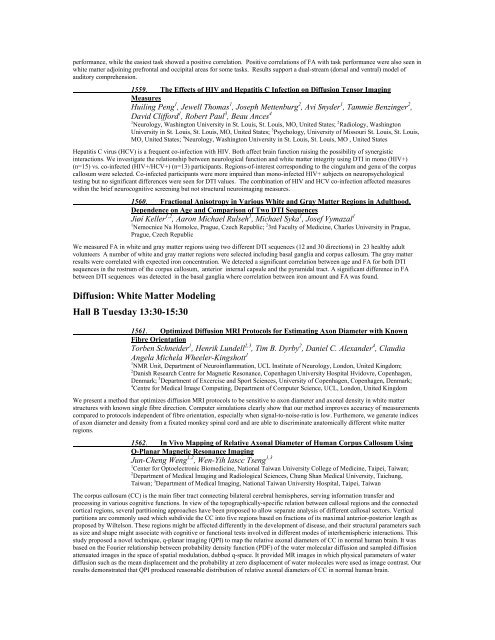Traditional Posters: Diffusion & Perfusion - ismrm
Traditional Posters: Diffusion & Perfusion - ismrm
Traditional Posters: Diffusion & Perfusion - ismrm
You also want an ePaper? Increase the reach of your titles
YUMPU automatically turns print PDFs into web optimized ePapers that Google loves.
performance, while the easiest task showed a positive correlation. Positive correlations of FA with task performance were also seen in<br />
white matter adjoining prefrontal and occipital areas for some tasks. Results support a dual-stream (dorsal and ventral) model of<br />
auditory comprehension.<br />
1559. The Effects of HIV and Hepatitis C Infection on <strong>Diffusion</strong> Tensor Imaging<br />
Measures<br />
Huiling Peng 1 , Jewell Thomas 1 , Joseph Mettenburg 2 , Avi Snyder 1 , Tammie Benzinger 2 ,<br />
David Clifford 1 , Robert Paul 3 , Beau Ances 4<br />
1 Neurology, Washington University in St. Louis, St. Louis, MO, United States; 2 Radiology, Washington<br />
University in St. Louis, St. Louis, MO, United States; 3 Psychology, University of Missouri St. Louis, St. Louis,<br />
MO, United States; 4 Neurology, Washington University in St. Louis, St. Louis, MO , United States<br />
Hepatitis C virus (HCV) is a frequent co-infection with HIV. Both affect brain function raising the possibility of synergistic<br />
interactions. We investigate the relationship between neurological function and white matter integrity using DTI in mono (HIV+)<br />
(n=15) vs. co-infected (HIV+/HCV+) (n=13) participants. Regions-of-interest corresponding to the cingulum and genu of the corpus<br />
callosum were selected. Co-infected participants were more impaired than mono-infected HIV+ subjects on neuropsychological<br />
testing but no significant differences were seen for DTI values. The combination of HIV and HCV co-infection affected measures<br />
within the brief neurocognitive screening but not structural neuroimaging measures.<br />
1560. Fractional Anisotropy in Various White and Gray Matter Regions in Adulthood.<br />
Dependence on Age and Comparison of Two DTI Sequences<br />
Jiøí Keller 1,2 , Aaron Michael Rulseh 1 , Michael Syka 1 , Josef Vymazal 1<br />
1 Nemocnice Na Homolce, Prague, Czech Republic; 2 3rd Faculty of Medicine, Charles University in Prague,<br />
Prague, Czech Republic<br />
We measured FA in white and gray matter regions using two different DTI sequences (12 and 30 directions) in 23 healthy adult<br />
volunteers A number of white and gray matter regions were selected including basal ganglia and corpus callosum. The gray matter<br />
results were correlated with expected iron concentration. We detected a significant correlation between age and FA for both DTI<br />
sequences in the rostrum of the corpus callosum, anterior internal capsule and the pyramidal tract. A significant difference in FA<br />
between DTI sequences was detected in the basal ganglia where correlation between iron amount and FA was found.<br />
<strong>Diffusion</strong>: White Matter Modeling<br />
Hall B Tuesday 13:30-15:30<br />
1561. Optimized <strong>Diffusion</strong> MRI Protocols for Estimating Axon Diameter with Known<br />
Fibre Orientation<br />
Torben Schneider 1 , Henrik Lundell 2,3 , Tim B. Dyrby 2 , Daniel C. Alexander 4 , Claudia<br />
Angela Michela Wheeler-Kingshott 1<br />
1 NMR Unit, Department of Neuroinflammation, UCL Institute of Neurology, London, United Kingdom;<br />
2 Danish Research Centre for Magnetic Resonance, Copenhagen University Hospital Hvidovre, Copenhagen,<br />
Denmark; 3 Department of Excercise and Sport Sciences, University of Copenhagen, Copenhagen, Denmark;<br />
4 Centre for Medical Image Computing, Department of Computer Science, UCL, London, United Kingdom<br />
We present a method that optimizes diffusion MRI protocols to be sensitive to axon diameter and axonal density in white matter<br />
structures with known single fibre direction. Computer simulations clearly show that our method improves accuracy of measurements<br />
compared to protocols independent of fibre orientation, especially when signal-to-noise-ratio is low. Furthemore, we generate indices<br />
of axon diameter and density from a fixated monkey spinal cord and are able to discriminate anatomically different white matter<br />
regions.<br />
1562. In Vivo Mapping of Relative Axonal Diameter of Human Corpus Callosum Using<br />
Q-Planar Magnetic Resonance Imaging<br />
Jun-Cheng Weng 1,2 , Wen-Yih Iascc Tseng 1,3<br />
1 Center for Optoelectronic Biomedicine, National Taiwan University College of Medicine, Taipei, Taiwan;<br />
2 Department of Medical Imaging and Radiological Sciences, Chung Shan Medical University, Taichung,<br />
Taiwan; 3 Department of Medical Imaging, National Taiwan University Hospital, Taipei, Taiwan<br />
The corpus callosum (CC) is the main fiber tract connecting bilateral cerebral hemispheres, serving information transfer and<br />
processing in various cognitive functions. In view of the topographically-specific relation between callosal regions and the connected<br />
cortical regions, several partitioning approaches have been proposed to allow separate analysis of different callosal sectors. Vertical<br />
partitions are commonly used which subdivide the CC into five regions based on fractions of its maximal anterior-posterior length as<br />
proposed by Wiltelson. These regions might be affected differently in the development of disease, and their structural parameters such<br />
as size and shape might associate with cognitive or functional tests involved in different modes of interhemispheric interactions. This<br />
study proposed a novel technique, q-planar imaging (QPI) to map the relative axonal diameters of CC in normal human brain. It was<br />
based on the Fourier relationship between probability density function (PDF) of the water molecular diffusion and sampled diffusion<br />
attenuated images in the space of spatial modulation, dubbed q-space. It provided MR images in which physical parameters of water<br />
diffusion such as the mean displacement and the probability at zero displacement of water molecules were used as image contrast. Our<br />
results demonstrated that QPI produced reasonable distribution of relative axonal diameters of CC in normal human brain.















